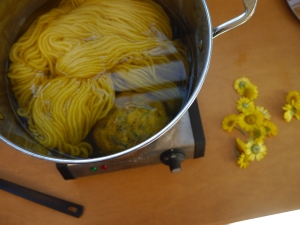 After harvesting flowers from our garden and gathering onion skins from the school kitchen we were ready to make our first colors of the year. Whether fresh or dried we wrapped our plant material in cheese cloth so it wouldn’t get stuck in the yarn. We then put it in pots of warm water and added the yarn (which had been previously cooked with a little alum & cream of tartar and rinsed out). We then raised the temperature and watched as the water changed color. While it cooked students drew the dye plants in their color journals and guessed what colors we would get.
After harvesting flowers from our garden and gathering onion skins from the school kitchen we were ready to make our first colors of the year. Whether fresh or dried we wrapped our plant material in cheese cloth so it wouldn’t get stuck in the yarn. We then put it in pots of warm water and added the yarn (which had been previously cooked with a little alum & cream of tartar and rinsed out). We then raised the temperature and watched as the water changed color. While it cooked students drew the dye plants in their color journals and guessed what colors we would get.  After harvesting flowers from our garden and gathering onion skins from the school kitchen we were ready to make our first colors of the year. Whether fresh or dried we wrapped our plant material in cheese cloth so it wouldn’t get stuck in the yarn. We then put it in pots of warm water and added the yarn (which had been previously cooked with a little alum & cream of tartar and rinsed out). We then raised the temperature and watched as the water changed color. While it cooked students drew the dye plants in their color journals and guessed what colors we would get.
After harvesting flowers from our garden and gathering onion skins from the school kitchen we were ready to make our first colors of the year. Whether fresh or dried we wrapped our plant material in cheese cloth so it wouldn’t get stuck in the yarn. We then put it in pots of warm water and added the yarn (which had been previously cooked with a little alum & cream of tartar and rinsed out). We then raised the temperature and watched as the water changed color. While it cooked students drew the dye plants in their color journals and guessed what colors we would get.
One interesting result: each time we used the marigolds a slightly different color emerged! This is not surprising given the many variables at play. We had variations in the yarn (or yarn preparation), the time of day flowers were harvested, the amount of flowers used, the temperature of the water, the amount of time cooked and the amount of time left to soak. Any of those could have affected our color, which left us to ponder what we might do differently next time to control the color better.


